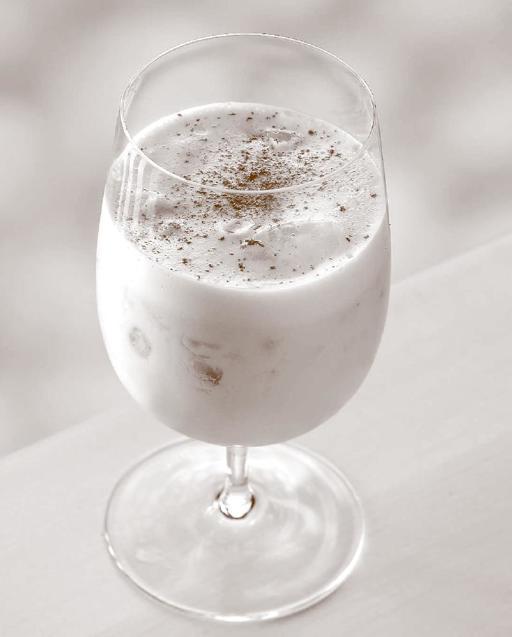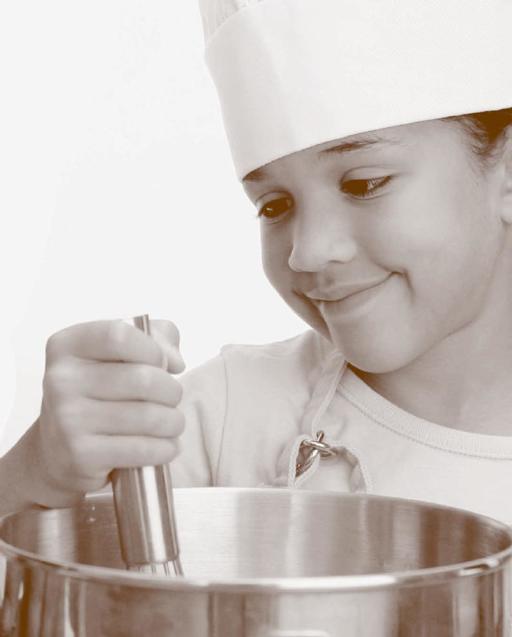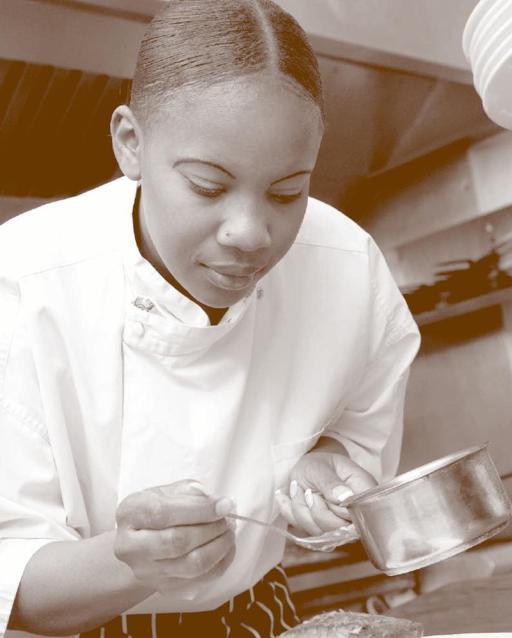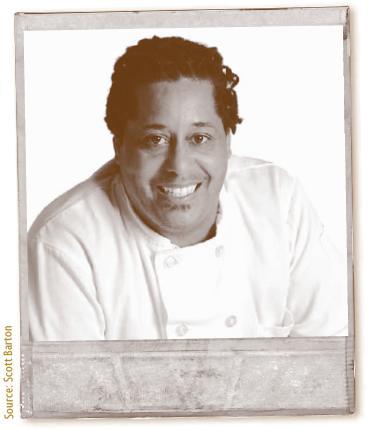America I AM Pass It Down Cookbook (40 page)

Pass It Down TIP
1883 De Philibert Routin produces extremely high quality natural syrups like the one for pomegranate used in this recipe—from watermelon and roasted hazelnut syrup to coconut and chai. These syrups contain no artificial flavoring or preservatives and are available online at
Amazon.com
.
Really Exciting Fruit Punch
SERVES 8 TO 10
“Nothing says summertime like family reunions. Every year my family and I get together to catch up, reminisce, and have an all around great time,” says Jeniece Isley, founder of Get ’Em Girls. “This Really Exciting Fruit Punch is an absolute must. It’s super easy, versatile, and you don’t have to worry about the kids knocking over your beloved punch bowl. For an adult’s-only version, substitute 750 ml or one bottle of Prosecco or sparkling white wine for 3 cups of sparkling water right before serving.
½ large seedless watermelon
1 12-ounce can frozen pink lemonade concentrate
1 6-ounce can frozen limeade concentrate
5 cups chilled sparkling water or seltzer
1 pint lime sherbet
1 lime, washed and thinly sliced
Trim just enough of the bottom of the watermelon half to create a flat base and stabilize it. Hollow out the watermelon by scooping out the flesh until only the pale green interior shows. Freeze the rind for at least 1 hour or until ready to make the punch.
To make the punch, puree 4 cups of watermelon pulp in batches in a blender until smooth. Transfer to a large bowl or pitcher. Stir the lemonade and limeade concentrate into the bowl with the puree until completely melted. Refrigerate until ready to serve; it can be made the night before.
When ready to serve, pour the sparkling water or seltzer into the punch mixture and gently stir to combine. Pour the punch into the watermelon shell and float small scoops of the sherbet on top of the punch. Garnish with the lime slices and serve immediately.

Pass It Down Classic Homemade Eggnog
SERVES 8 TO 10
This special holiday treat is simple to make and can be stored in the icebox for 3–4 days. The Jamaican rum gives the beverage a little kick, but can be left out so the kids can enjoy it too.
8 egg yolks
1 cup sugar
4 cups milk
2 cinnamon sticks
3 whole cloves
2 cups heavy cream
2 teaspoons vanilla extract
3 teaspoons freshly grated nutmeg
3 tablespoons Jamaican rum or to taste
In a large bowl, beat egg yokes by hand thoroughly. Then slowly stream in the sugar and whisk until fluffy. Add the milk, cinnamon, and cloves in a heavy bottomed pot. Slowly heat mixture on medium heat until hot, but not boiling.
Temper the eggs by slowly adding half of the hot milk mixture into the eggs while whisking constantly. Pour the mixture back into the saucepan.
Cook on medium heat, stirring repeatedly with a wooden spoon until the mixture begins to thicken and coats the back of the spoon. Do not allow the mixture to boil or it will curdle. However, if the mixture does curdle, you may be able to save it by running it through a blender.
Remove from heat and stir in the cream. Strain the mixture using a strainer to remove the cloves. Let cool for one hour.
Mix in the vanilla extract, nutmeg, and Jamaican rum. Serve cold or warm.

CHAPTER
11
Generation Next:
Cooking with Kids
and Young Chefs

Jumping into Taste
Exploring the Pleasure of Cooking with Kids
BY CHEF SCOTT ALVES BARTON

Since his first days as pot washer to the chefs at a country club when he was just 14 and a half years old, Scott Alves Barton has continually worked as a baker, executive chef, culinary consultant, and teacher to children and adults. He was honored in the first crop of
Ebony
magazine’s top African American and African chefs. He has been invited to cook at the James Beard House and has been featured on national television. Currently, Chef Barton is completing research fellowships in the culinary history of Bahia, Brazil and Macao, China, as well as his doctoral work in food studies at New York University in Manhattan.
M
y road to becoming an executive chef
began somewhere just around the middle of my third year. My mother, Sylvia, an educator and nutritionist who had once dreamed of becoming a great chef, expanded our horizons for play and taste by making our family kitchen a structured “play” center.
We were given the simplest tasks at first—counting out eggs and learning to measure with special spoons and cups. We later learned to make our favorite dishes, snacks, and sweets. Not long after, we began taking turns preparing part or all of the family dinner with her. In this way, she passed on her love of food and sense of culinary adventure to us, as she allowed us to explore a variety of foods, flavors, textures, aromas, cultures, and rituals used in preparing, serving, and eating our meals.
As we grew, my brother Craig and I were taught how to make whatever dish was our favorite. This allowed us a certain independence in the kitchen. By junior high school our chores included making some part or all of the family meal on a rotating basis. This helped my folks out, since they both worked all day. When Mom came home we often finished up the hard bits of the meal, and after dinner and homework we planned our next culinary adventure.
We nurture our children and check their progress in many ways, observing their capabilities with gross and fine motor skills, alphabets, and numbers. These simple activities and tests can serve as a clue to their potential and provide tools they’ll use throughout life.
Unfortunately, we often wait until they’re teenagers to think about educating their sense of taste, a valuable tool that will guide them throughout their lives. Whether we use taste to determine freshness and protect us from tainted foods as primitive man did, or for sensory pleasure and better nutrition, we need to stimulate our palates to foster good eating habits and ensure a love of diverse foods. This special section can be a jumping off point for both you and your children to enter a new world.
When cooking with your kids, I always stress good hygiene in all culinary activities. It is especially important that adults supervise when fire and sharp objects are used. Beyond the caution, remember that with guidance and supervision, many tasks can become adventures. With a zip-lock bag, a plastic disposable knife, and a few tools, young chefs can build their skills. The kitchen can be a laboratory to explore various subjects—mathematics, history, science, economics, anthropology, etc.
If we embrace the opportunities offered in our kitchens, a thousand worlds, flavors, and people will grace our dinners.
Mango Lassie
Chef Barton Kid-Friendly Recipe
Chef Barton notes that in India, this traditional beverage is both cooling and nutritious. Curiously, it usually has enough salt to give it a bite, yet it still fights dehydration that can occur in hot, subtropical countries wherever mangoes are plentiful. In America you can decide how you want to season it. Once you’ve mastered mango lassies, experiment with other fruits, such as bananas, pears, or combinations of various seasonal fruits.
FOR EACH CHILD
1 ripe mango or frozen mango purée
4 ounces plain yogurt
¼ cup cold milk or water
pinch brown sugar, if desired
freshly squeezed juice of ½ lime
TOOLS
covered quart container
long spoon for stirring
drinking cup
whisk, if needed
Pass It Down TIP
If desired, you can substitute soy milk for yogurt and add 2 tablespoons of soft tofu to turn this into a protein shake.
Peel mango, discard skin. Cut away the big seed by slicing directly through the fruit from tip to tip, around the edge of the seed. (You could try to sprout it in water like an avocado for a science project.) Cut the largest pieces into 1–2-inch pieces and purée them in a blender. This should give you about 1 cup of puréed mangoes.
Using a spatula, scrape the purée into a quart container with a tight-fitting lid. Or, if using store-bought purée, simply place in the pint container with tight-fitting lid.
Place the yogurt, water, sugar, and lime juice into the container. Now it’s time for your young chef partner to step in. Carefully secure the cover tightly on your container. Holding the container firmly with two hands, shake and blend, and let your young chef GO! Alternatively, you can let your young chef whisk the ingredients together by hand.
Taste to adjust for more sugar or lime juice as needed.
Old-Fashioned Buttermilk Hotcakes
Chef Barton Kid-Friendly Recipe
Have children smell and taste buttermilk, nutmeg, and cornmeal for texture and flavor.
FOR EACH CHILD
1 egg
¾ cup buttermilk
1 tablespoon butter, melted
½ cup all-purpose flour
¼ cup stone-ground cornmeal
1 teaspoon baking powder
pinch salt
pinch nutmeg
½ pint strawberries, hulled and cut into quarters for garnish
yogurt as garnish (optional)
maple syrup
wheat germ as garnish (optional)
TOOLS
2 bowls, wooden spoon, and spatula
griddle or cast iron skillet
pancake spatula
Have each ingredient in a separate container for each child.
In one bowl, combine egg, buttermilk, and butter. Stir to blend. Stir together the flour, cornmeal, baking powder, salt, and nutmeg. Mix into egg mixture and stir until just combined. If batter is a bit lumpy, that’s a good thing. Over-mixed is a bad thing.
Heat griddle and lightly grease. Drop batter by spoonfuls onto griddle. Cook over medium heat and watch for bubbles to form on the top surface.